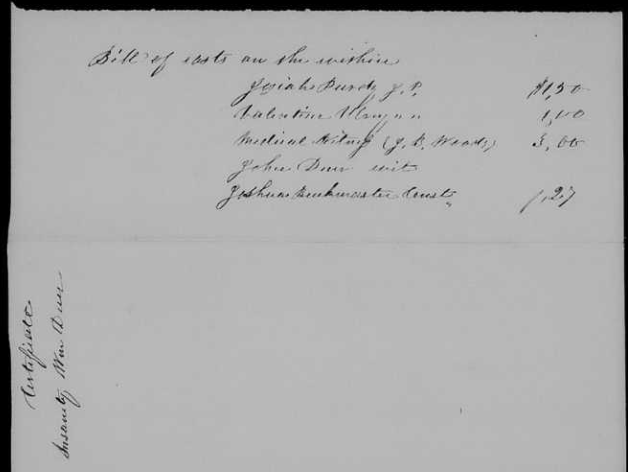
Certificate of Insanity, William Duer, May 1852; digital image, FamilySearch.org: Accessed 27 December 2020, citing Common Pleas Court civil records, 1825-1901 ; civil index, 1825-1900 Miscellaneous, 1846-1873 Miscellaneous (alphabetical), pre-1900 Depositions (chronological), 1886-1901. Film # 008271767, image 921 of 2904.
Usually, I’m happy when I climb over a brick wall but sometimes the find provides harsh reality of what the individual was experiencing. I recently had such a discovery and in all honesty, I put off writing about it for a month.
I’ve made a lot of progress on my John and Jane Duer line lately although several mysteries remain, like where is John buried, why does Jane’s tombstone say “wife of John Duer” when he was married to someone else at the time of Jane’s death and why does Jane’s youngest children, who were adults when she died, not tell their own children about Jane as evidenced by their death certificates stating mother is unknown?
My working theory is, among other reasons, because of the sad discovery I made regarding one of John & Jane’s children.
William Duer (1828-c. 1852) was the oldest son and oldest surviving child of John and Mary “Jane” Duer; he relocated with the couple from Trumbull County, Ohio where he was most likely born to Killbuck, Holmes, Ohio where he is shown residing with his parents and siblings in 1850. That census shows that William and his closest aged sibling, Thomas, was working on the farm with father John.
For years, I had difficulty discovering what became of William as he was not shown with the family in the 1860 census in Mercer County, Ohio where they had relocated, nor was he found in any census anywhere. He seemed to have disappeared in thin air as nothing was found for him anywhere. Until now and thanks to the images on FamilySearch.org.
I mentioned a few weeks ago how to access those images so click this link if you don’t know how.
My search for William took the usual path over the years – checking all the online sites, family trees and connecting with known relatives. I thought he had perhaps died in the Civil War which wouldn’t explain where he was in 1860, but I also had another missing brother from the 1860 census so I figured they may have been together somewhere and missed the enumeration. That brother, John B., eventually ended up in Adams County, Indiana. William was never found again. Until now.
I decided to look through the images for Common Plea Court Civil Records, 1825-1901, for Killbuck Township, Holmes, Ohio where the family lived to see if a record may exist for anyone in the family. That’s where I discovered the Certificate of Insanity for William Duer.
From the medical report, I learned that William was age 23 and free from infection. In March 1852 William complained of “feelings in his head” that lasted 1-2 weeks. He was last reported sane on 12 April 1852.
Apparently, insanity must have been shown for at least 30 days before the courts could be contacted. The physician diagnosed William with melancholy that was not related to hereditary or epilepsy. He was not violent. His past medical history showed bleeding and blisters but it does not clarify the cause.
Interestingly, the physician noted William had received “no education” and “worked hard” and had “no amusement” yet he was not “disappointed” by his life. The education information is verified by Historical Collection of the Mahoning Valley which stated “the public schools were few, with little interest taken in public education until 1840, when a new impulse moved the settlers” (p. 484). William’s early life was in Trumbull County which became Mahoning County.
The Justice of the Peace had also visited William at his home and found him insane. Since he was a resident of Killbuck, he was sent to the Ohio Lunatic Asylum to undergo treatment. His condition had been the case for less than 2 years. The reason cited for committing William was that “his being at large would be dangerous to the safety of the community.” Although this clearly conflicts with the physician report stating that William was not violent, father John Duer attested the same.
I do not believe William every survived the commitment. I suspect he is buried on the asylum grounds where there are numerous unmarked graves. I will be following up with an organization that holds the records which is currently closed due to the pandemic.
I hadn’t expected this would be the reason for the brick wall.
From searching through images, prior to this find, I discovered a letter to the courts regarding another community member’s request for an insanity hearing in the preceding year. The request was denied, not because the woman wasn’t insane, but because the county had already used up all of their bed space in the asylum. I have no idea from the records what the county’s allotted number was but it is telling that there were more community members who needed mental health assistance then there was available treatment for them.
This find leads me to a new working theory about William’s mother, Jane, that I will explore in more details next time.
